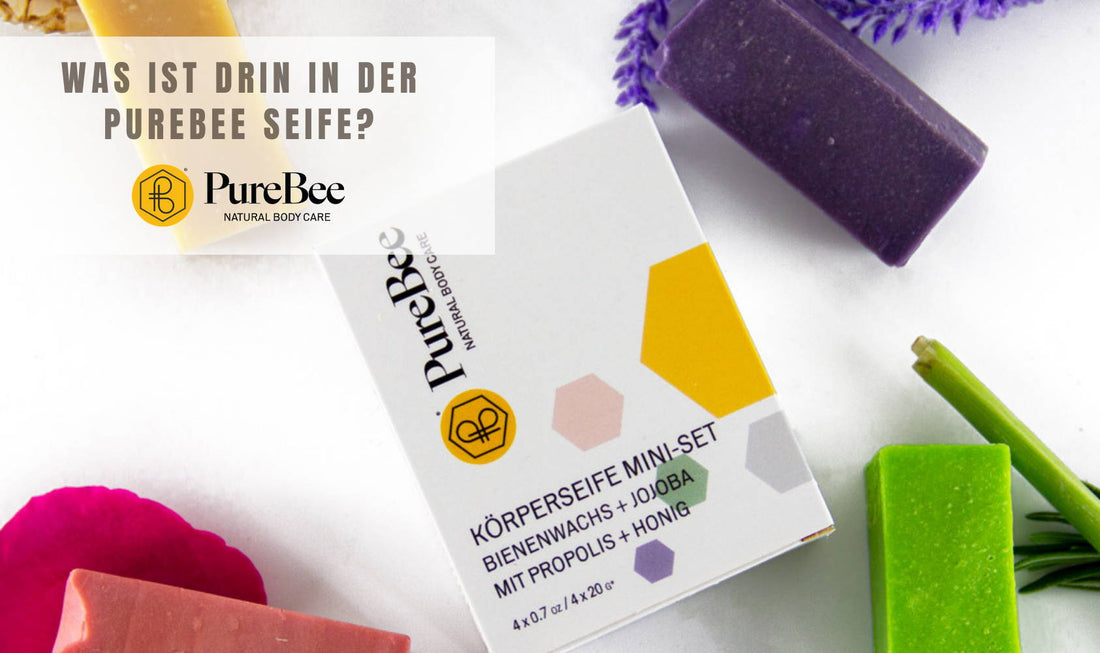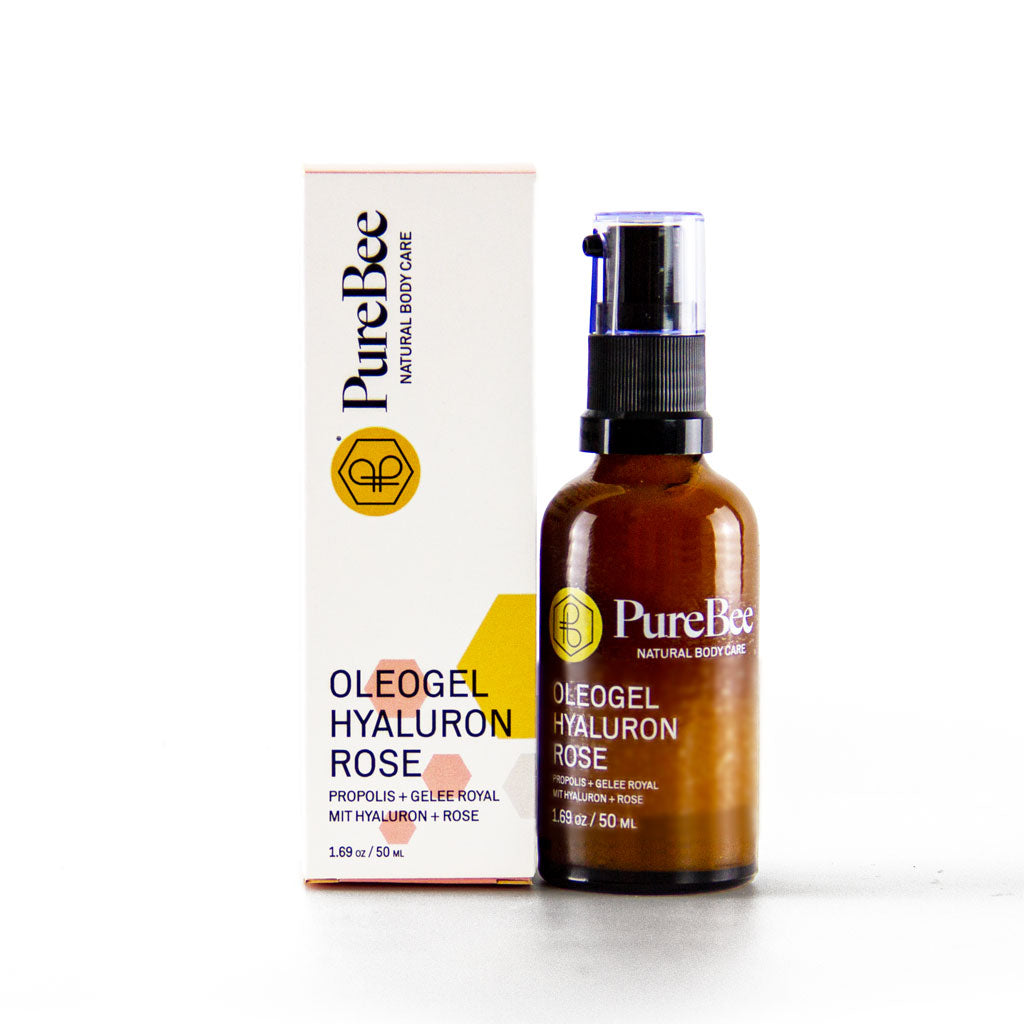Our soaps contain natural vegetable oils, wax and vegetable butters: coconut oil, olive oil, mango butter, apricot kernel oil, canola oil, beeswax and jojoba oil. These oils are mixed with caustic soda, which initiates the saponification process. Our natural soaps are colored with natural mineral pigments. No artificial substances are used - nature provides everything you need to produce healthy and sustainable body care. The oils are supplemented by the active ingredients honey and propolis. As with all our products, the ingredients are clearly and concisely specified.

What's in the PureBee soap?
Share
What ingredients are in the soaps?
What fragrances are used in the soaps?
For scenting, we only use natural, essential oils. These natural essential oils also consist of fragrances that can trigger allergies, which is why these allergenic fragrances must be specified in the ingredients (for example, in the case of lemongrass oil, these are citral and geraniol). However, the specified allergens, which you can find in our ingredients list, all come from the natural essential oils. Not all PureBee soaps are scented, for sensitive skin we recommend our Original hand and body soap without scent.
| Soap | hand soap | shower and bath soap | hair soap | fragrance addition | color addition | overfatting |
|
Yes |
Yes |
no |
no |
no |
7% |
|
|
Yes |
Yes |
no |
Lemongrass Oil + Rosemary Oil |
Mineral pigments green + mica |
7% |
|
|
Yes |
Yes |
no |
Geranium Oil + Rose Oil + Orange Oil |
Mineral pigments white + red + mica |
7% |
|
|
Yes |
Yes |
no |
lavender oil |
Mineral pigments violet |
7% |
How are the soaps made?
Our natural soaps are made using the gentle cold mixing process. We mix fats and oils with caustic soda (NaOH or sodium hydroxide), which is provided especially for cosmetics production. It is important to find the right relationship. Every oil needs a certain amount of lye in order to be able to form a soap that is not too alkaline or not too oily. If the amount of lye is too small, not all oils are saponified and the soap becomes greasy. After fat and lye have been mixed, the lengthy process of saponification begins. The secret of handmade soaps lies in this cold process. Chemically, fats and oils consist of fatty acids and glycerin. Three fatty acid molecules attach themselves to one glycerol molecule. This is why we also speak of triglycerides. During saponification, this fat molecule is broken down, the three fatty acid parts each combine with a lye molecule and thus form a "salt" of acid and base, i.e. a soap molecule. The glycerin remains in this process. The soap industry is washing that glycerine out of soap right now! It is too valuable for industry and can be used elsewhere. During the cold process, however, the natural glycerine remains in the soap and can thus develop its caring properties. This is why cold stirred soaps are much gentler and also milder than industrially made ones.
Finally, the essential oils, mineral pigments, honey and propolis are added and the glue is poured into moulds. Depending on the type of soap, the glue rests in the mold for a few hours to several days and sets. After shaping, we cut the soap blocks into neat, manageable 100g pieces (or 20g pieces for the minis). After cutting, the bars of soap can make themselves comfortable on the shelf and mature for 6-8 weeks. They are then checked again for quality, packaged and sold. The cold stirring process is very gentle and the wonderful ingredients of the precious organic oils are not destroyed. The contained glycerine is created during the saponification process, no glycerine is added and acts as a moisturizer due to its water-binding properties.
What does fresh weight mean?
What surfactants are in the soap?
Surfactants are molecular chains that adhere to water on the one hand and to fats on the other. Without surfactants there would hardly be any washing effect and we need them to clean our skin. Therefore, we find surfactants in shower gels, shampoos, soaps and everything that is intended for cleaning.
There are therefore many different surfactants and they can be harmless or very problematic! The surfactants (chemical: sodium salts of fatty acids) formed in the natural soaps by saponifying the vegetable oils and fats with caustic soda are all gentle on the skin and completely biodegradable. No surfactants are added, hence the term "natural soap". During the slow saponification, sufficient glycerine is naturally formed, as well as valuable fat by-products (so-called unsaponifiables), which remain in the soap.
The widely used industrial soaps are made from a ready-to-use mass that contains artificial surfactants, such as dishwashing detergents or laundry detergents. So-called "glycerin soaps" (transparent soaps) are also made from it. The fact that glycerine is added, and maybe one or the other natural active ingredient, does not make these soaps natural soaps!
Shampoos and shower gels should be produced with mild, purely plant-based surfactants such as sugar surfactants.
Does the soap contain palm oil?
Palm oil is obtained from the pulp of the oil palm. The demand and production of palm oil has risen sharply in recent years and it is now the most widely grown vegetable oil in the world. Palm oil has great foaming properties, especially in soap, which is why it is very popular in natural soaps. For the sake of the environment, we consciously avoid palm oil wherever possible and a good soap does not need palm oil to foam and care. Therefore, none of our soaps contain palm oil.
Where are the soaps made?
Like all our cosmetic products, we produce the soap by hand in our manufactory in Graben-Neudorf (Baden-Württemberg)
Do the soaps contain preservatives?
No, real natural soaps do not need a preservative because they are slightly alkaline (pH value 8-9) and therefore germs have difficulty multiplying.

